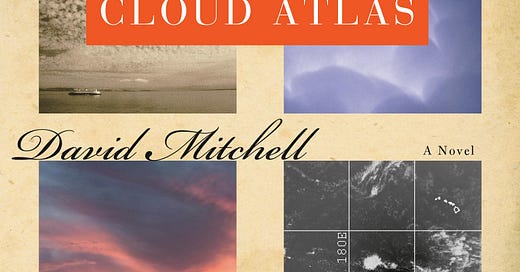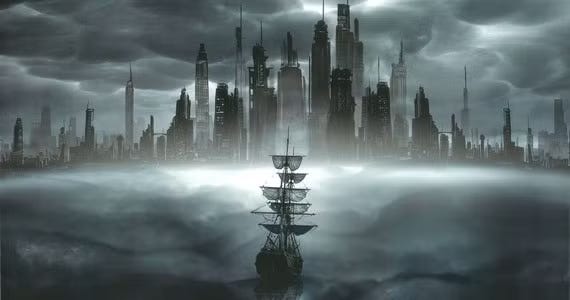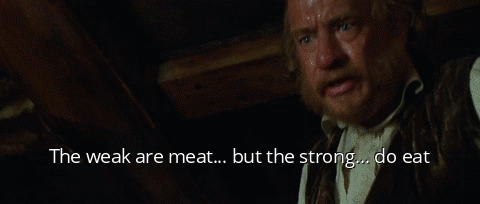& only as you gasp your dying breath shall you understand, your life amounted to no more than one drop in a limitless ocean!
Yet what is any ocean but a multitude of drops? (Cloud Atlas, 508)
Cloud Atlas is the third novel of British author David Mitchell. The book consists of six-related novellas that are nested inside each other like Matroyshka dolls: you read the first half of each novella before the “flip” in the sixth story where you start reading the second half of each piece. The work deals with the nature of media: how structure effects function and theme, and on personal salvation in a pessimistic, fallen world. I have read the book four times and will probably read it another four before I die. There’s also a movie by the Wachowskis, which is okay, but there are a couple of pretty significant plot changes that undermine the message of the books.
I have a long history with Cloud Atlas, and even as I move away from it towards more challenging literature, the book will always have a place in my heart. It was the book that got me out of my long secondary school reading slump, and helped me to realize I wanted to be a man of letters.1 It was also the book that helped me to realize that there could actually be significant value in literature beyond just entertainment value: in the experiencing of various philosophical ideas rather than their explication.
Cloud Atlas is a work of post-modernist fiction, in the sense that its structure is important to its themes, like Infinite Jest by David Foster Wallace, or the video game Dark Souls.2 The book consists of six interlocking stories, spanning from 1850 to the medium-term future after some kind of environmental/nuclear apocalypse has occurred. The form and genre of each story span the full range of literary possibilities, from the Melville-like Pacific Journal of Adam Ewing, to the crime-thriller Half-Lives: The First Luisa Rey mystery, to the post-apocalyptic oral history of Sloosha’s Crossin’ an’ Everthin’ After.3 Mitchell is quite pessimistic on a societal level: his other two novels that are similarly era-spanning end with an omniscient AI zookeeper deciding to allow a comet to hit earth (Ghostwritten) because humans are the worst, or with the slow motion collapse of Ireland in the face of migration and resource shortages (The Bone Clocks). In a slightly different way than Houellebecq, this dude really gets it.
It’s thus not that surprising that none of his protagonists in Cloud Atlas manages to dismantle or overcome the systems of oppression that drive the plot of the work. However, this does not stop most of the main characters from exercising some form of personal virtue. Somni still gives her Orison, Robert finishes his music, Timothy escapes imprisonment, and Zachary leads Meryonym to safety. I think this is a rather cogent philosophy to argue for in the face of the obvious societal disfunction that looms large in all our lives as we transition from the Age of Pisces to the Age of Aquarius. You can’t save society, but you can save yourself4.
Form and truth
I keep coming back to Neil Postman’s and Marshall McLuhan’s insights that the form of media is just as important, if not more, than the message contained within. This is very obvious in the case of something like Television, or Twitter, but is less easy to see within a book, which some would consider to be a singular form of media. However, the nature of different types of written communication, from journals to the oral pidgin of the sixth segment, subtly influence the way the story is communicated. For example, the second segment is a series of letters from the Bohemian musician Robert Frobisher to his gay lover in the 1930s. This style of writing not only invites us to imagine the replies of his lover Sixsmith, but also to reflect on the slant that Frobisher puts on the events that he recounts because of who his audience is. Contrast this with the first segment, which a personal diary of the good-natured but rather passive Adam Ewing. Due to the nature of the form of writing (diary), Adam Ewing is much more forthright than Frobisher, which means we have to interpret this part of the novel in a very different light than that of the epistles. Mitchell pushes this even further in the final two segments of the novel, where language itself begins to warp as a reflection of the goings on of the outside world. In the fifth segment, which takes place in a near-future Korea, common nouns have been replaced by names of corporations (car=ford, electronic device=sony, etc.), and in the sixth segment the English language is nearly unrecognizable.
I watched clouds awobbly from the floor ' that kayak. Souls cross ages like clouds cross skies, an' tho' a cloud's shape nor hue nor size don't stay the same, it's still a cloud an' so is a soul. Who can say where the cloud's blowed from or who the soul'll be 'morrow? Only Sonmi the east an' the west an' the compass an' the atlas, yay, only the atlas o'clouds.
Another aspect of this interrogation of form and function is the appearance of each story as an artifact in the following story: the Luisa Rey Mystery is a draft manuscript that Timothy reads in the Ghastly Ordeal of Timothy Cavendish. This brings up the question of truth Are we indeed reading the same works that the characters are implied to be? Somni's Ghastly Ordeal of Timothy and the one written here are not the same. Mitchell says as much, in one of his Luisa Rey chapters: the past is merely a constructed version of actual events that are totally lost to us.
There’s another interesting aspect of form that’s present in the novel: a speed-up in my reading after the flip, almost like I’m hurtling downwards toward a precipice after climbing up a mountain. This is most obvious in the central story where the middle of the novellete involves an ascent/descent of Mauna Kea , but there are also motifs of "falling" in other stories on the descent as well (Luisa's car and the bridge, Timothy's stroke, fabricant being thrown off the bridge in Somni's interview, descent from the tower in Bruges being the beginning of the end for Frobisher).
Will to Power and the Age of Aquarius
one fine day, a purely predatory world shall consume itself. Yes, the Devil shall take the hindmost until the foremost is the hindmost. In an individual, selfishness uglifies the soul; for the human species, selfishness is extinction
As I stated earlier, Cloud Atlas is a pretty pessimistic book. The good guys may come out on top during the course of the plot, but they don’t actually change history. Rather, it is those who best emphasize Nietzche’s Will to Power5 (might=right), that seem to succeed in this world. This connection to Nietzche is pretty obvious: multiple characters name drop him, and there’s also some exploration of the idea of eternal recurrence through reincarnation and recurrence of exploitation in different ages of the world. The themes of exploitation and corruption of civilization would have worked well at any point throughout history, yet Mitchell chooses to start his tale in modernity (~1850s). I think there's a couple reasons for this.
The literary forms that Mitchell chooses for these six novelettes reflects something about the spirit of each time period. While things like oral histories, epistles, and interviews have been present throughout all of history, three of the six stories are novels of some kind, a form that is unique to our times, and unparalleled in its ability to illuminate character.
The start of the novel also coincides with the advent of global capitalism, and its end with the absolute destruction of the global environment and forms of social organization. The particularly brutal and transactional nature of the exploitation cataloged in these pages may, in Mitchell's eyes, have more to do with the worship at the altar of mammon than with something central to human nature.
Thirdly, and this is a stretch, the events of the six stories all take place during the transition between the age of Pisces and the age of Aquarius. Pisces was the age of mass religious movements, and community enforced morality. Aquarius will see more of a focus on the personal salvation/ascension of the individual. Which is exactly what we see in the stories of each of these six characters: an individual making a stand against a rising tide of collective barbarism.
With the exception of the Luisa Rey mystery, most of these stories take place around Christmas: not sure what to make of that, but it's present too frequently to be meaningless. Christ’s birth began the Age of Pisces: perhaps this is an echo of something similar ending it.
Problems with the Film
The film, produced by the Wachowski’s back when they were still brothers, makes a number of bold cinematic choices (such a reusing actors in each story to more clearly underline the theme of reincarnation), but I think ultimately falls flat because of a thematic misalignment with the book. The protagonist of the sixth story is implied to have escaped to space, to transcend the cycle of violence, which is a juvenile fantasy due to numerous physical constraints. Rather than pessimism, this change encourages us to believe that transcendence is possible through technology, which is completely contrary to what Mitchell actually is saying in Cloud Atlas. Secondly, due the nature of the media, the film does away with the form differences between the six stories, which in some ways was unavoidable. There is an attempt to maintain genre: the Orison of Somni-451 maintains a distinctly different feel from the rest of segments of the movie, but this doesn’t quite cut it.
If you enjoyed this article, you can sign up for my mailing list here. I blog about language learning, biology, the science and art of learning, and many other things
Josh
I have a degree in creative writing from MIT, along with another in computational biology. Credentialism is gauche, but I learned a lot in my writing/literature classes, and I think they were pretty important to my personal development.
Complete with a pidgin English dialect that Mitchell invented. I'‘ll be really curious to see how this is done in translation.
Various other authors on substack address this theme. Neoliberal Feudalism and Be Your Own Doctor are two of the best
The weak are meat the strong do eat one might say







